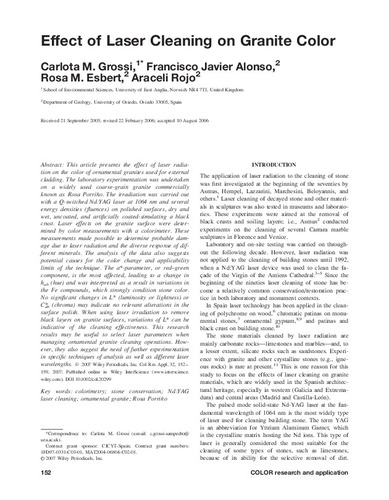Effect of laser cleaning on granite color
Fecha de publicación:
Citación:
Descripción física:
Resumen:
This article presents the effect of laser radiation on the color of ornamental granites used for external cladding. The laboratory experimentation was undertaken on a widely used coarse-grain granite commercially known as Rosa Porriño. The irradiation was carried out with a Q-switched Nd:YAG laser at 1064 nm and several energy densities (fluences) on polished surfaces, dry and wet, uncoated, and artificially coated-simulating a black crust. Laser effects on the granite surface were determined by color measurements with a colorimeter. These measurements made possible to determine probable damage due to laser radiation and the diverse response of different minerals. The analysis of the data also suggests potential causes for the color change and applicability limits of the technique. The a*-parameter, or red–green component, is the most affected, leading to a change in hab (hue) and was interpreted as a result in variations in the Fe compounds, which strongly condition stone color. No significant changes in L* (luminosity or lightness) or C*ab (chroma) may indicate no relevant alterations in the surface polish. When using laser irradiation to remove black layers on granite surfaces, variations of L* can be indicative of the cleaning effectiveness. This research results may be useful to select laser parameters when managing ornamental granite cleaning operations. However, they also suggest the need of further experimentation in specific techniques of analysis as well as different laser wavelengths.
This article presents the effect of laser radiation on the color of ornamental granites used for external cladding. The laboratory experimentation was undertaken on a widely used coarse-grain granite commercially known as Rosa Porriño. The irradiation was carried out with a Q-switched Nd:YAG laser at 1064 nm and several energy densities (fluences) on polished surfaces, dry and wet, uncoated, and artificially coated-simulating a black crust. Laser effects on the granite surface were determined by color measurements with a colorimeter. These measurements made possible to determine probable damage due to laser radiation and the diverse response of different minerals. The analysis of the data also suggests potential causes for the color change and applicability limits of the technique. The a*-parameter, or red–green component, is the most affected, leading to a change in hab (hue) and was interpreted as a result in variations in the Fe compounds, which strongly condition stone color. No significant changes in L* (luminosity or lightness) or C*ab (chroma) may indicate no relevant alterations in the surface polish. When using laser irradiation to remove black layers on granite surfaces, variations of L* can be indicative of the cleaning effectiveness. This research results may be useful to select laser parameters when managing ornamental granite cleaning operations. However, they also suggest the need of further experimentation in specific techniques of analysis as well as different laser wavelengths.
ISSN:
Patrocinado por:
Contract grant sponsor: CICYT-Spain. Contract grant numbers:IFD97-0331-C03-01.MAT2004-06804-C02-01
Ficheros en el ítem




